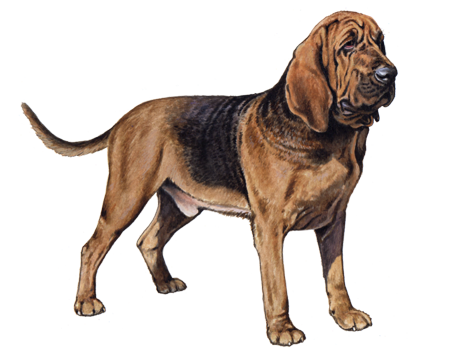
Hamiltonstövare
Though loyal and friendly, Hamiltonstovares can sometimes be wary of strangers and stubborn. That said, they're food-motivated, which makes them easy to train. As a hound, the Hamiltonstovare may chase smaller animals and requires a lot of exercise to remain happy and healthy. But with a little work, these dogs make wonderful companions.
Interested in discovering if your dog is a Hamiltonstövare?
Check out Wisdom Panel's DNA tests.

Hamiltonstövare Traits
General Appearance
The Hamiltonstovare is a strong, medium-sized breed with a rectangular body and long head.
Coat and Coloring
Hamiltonstovares have harsh coats that lie close to their bodies. The fur on the breed's head, ears, and front legs is short and smooth, whereas the fur under the tail and back of the thighs is slightly longer. These dogs are tricolored—their coats are black, tan, and white.
Distinctive Physical Traits
Besides their light frame, Hamiltonstovares share many physical characteristics with English Foxhounds. Their undercoats are short and soft—and especially thick in the wintertime, which makes the breed well-suited for cold, Nordic climates.
Hamiltonstövare Temperament
Most Hamiltonstovare fans find the breed's quirks charming. But there are a few personality traits to consider before bringing one home. For example, Hamiltonstovares can be very loud—particularly when they've found something of interest. Also, this breed is a hound at heart and will take chase when given the opportunity.
That said, Hamiltonstovares are relatively low-maintenance. And when home with their people, they tend to be friendly and even-tempered.


Hamiltonstövare History
Count Adolf Patrick Hamilton of Sweden (the founder of the Swedish Kennel Club) developed the Hamiltonstovare in the late 1800s. His goal was to produce a dog that could handle challenging climates and terrain while hunting hare and fox.
Hamilton crossed Harriers with English Foxhounds and three other now-extinct breeds from Germany. The resulting Hamiltonstovare showed in Sweden for the first time in 1921. Though they have started to gain popularity in places outside Sweden, Hamiltonstovares are still rare in America.
Fun fact: Hamiltonstovares prefer hunting alone or with one companion, as opposed to in a pack. This is a key difference between them and similar breeds.
Hamiltonstövare Care
Nutrition
Hamiltonstovares require a high-quality dog food formulated to their particular age, activity level, and size—as well as any additional health concerns. You should monitor how much your Hamiltonstovare eats, and reduce portions if they gain excess weight. Your veterinarian can also help you determine appropriate nutrition and feeding guidelines.
Grooming
Hamiltonstovares shed a low-to-moderate amount seasonally. During such times, brushing with a grooming mitt twice per week should suffice.
Trimming nails, cleaning ears, and brushing teeth should also be part of every dog's grooming routine, regardless of breed.
Exercise
Like most dogs that were bred to hunt, Hamiltonstovares are active and require a lot of exercise to stay healthy and happy. They seem to enjoy most activities. But their excellent hunting skills and high intelligence make them excellent candidates for dog sports. These include agility, nosework, barn hunting, rally, dock diving, and lure coursing.
Keep in mind that when they aren't adequately exercised—or when they're left alone for too long—Hamiltonstovares can get into trouble.
Training
Hamiltonstovares are smart and eager to please. And though they can have a stubborn, independent streak, they're highly food-motivated—which makes them easy to train. Reward-based training techniques tend to work best with this breed.
Early socialization and obedience training are essential for Hamiltonstovares due to their strong prey drive and hunting instinct.
Breed Group
Hound
The most common ancestral trait of this group is being used for hunting. Some use acute powers of scent to follow a trail while others demonstrate the gift of stamina as they run down a quarry. Beyond these two common traits, however, generalizations about hounds are hard to come by as the group is comprised of a very diverse lot of breeds.


































